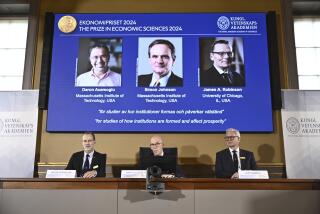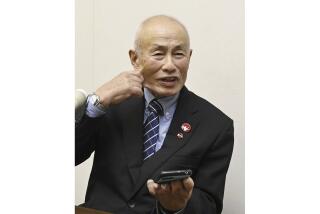Nobel Prize in physics honors 3 scientists for work that reveals the secrets of ‘exotic matter’

Professors David Thouless, Duncan Haldane and Michael Kosterlitz were awarded the Nobel Prize in physics for their work that “revealed the secrets of exotic matter.”
- Share via
Three scientists who elucidated the mysterious properties of exotic states of matter were honored Tuesday with the Nobel Prize in physics.
The discoveries made by David Thouless, Duncan Haldane and Michael Kosterlitz in the 1970s and 1980s laid essential groundwork for the field known as condensed matter physics. Their work could point the way to creating special materials with novel properties — and could even help make quantum computers a reality, according to the Royal Swedish Academy of Sciences, which selects the laureates for each prize.
For the record:
2:50 a.m. Oct. 5, 2016This article previously stated that the National High Magnetic Field Laboratory is at the University of Florida. It is headquartered at Florida State University.
“The physics itself is gorgeous,” said Laura Greene, chief scientist at the National High Magnetic Field Laboratory at Florida State University in Tallahassee. “But the applications — like better high-temperature superconductors, better ferroelectrics, better functional correlated electron materials — could be transformative.”
See the most-read stories in Science this hour »
In the ordinary world, matter exists in a few phases: solid, liquid, gas and an ionized state known as plasma. But other states are possible, too.
For many decades, scientists have been examining how matter behaves in extreme circumstances, such as when it’s cooled to within a few degrees of absolute zero. These experiments have turned up a slew of exotic phases where matter behaves in strange — and counterintuitive — ways.
For instance, researchers have made super-cooled helium crawl up the sides of a container. They’ve also turned certain materials into superconductors, allowing electrons to pass through with so little resistance that the charged particles approach the speed of light.
In these strange phases, scientists can see quantum mechanical effects at work in materials, unencumbered by the random motions of atoms.
Before Thouless and Kosterlitz’s work in the 1970s, scientists thought that phase transitions couldn’t occur in a two-dimensional material because thermal fluctuations would wipe out any semblance of order. The pair’s research upended prevailing theories, showing that superconductivity and superfluidity could indeed exist in a flat world.
In the 1980s, Thouless showed how the electrical conductance of two-dimensional matter changed in specific, integer-like steps — an example of a concept known as topology.
Haldane, meanwhile, was finding that topology could be used to understand the behavior of tiny chains of atomic magnets.
“Now, actually, the race is on, and you look for topological phases of matter in chains, in layers, but also ordinary three-dimensional materials,” Thors Hans Hansson, a member of the Nobel Committee for Physics, said during a briefing in Stockholm.
Haldane, who joined the briefing by phone, said he was “surprised ... and very gratified” to win the award.
“At the time I felt it was of scientific interest and mathematical interest,” he said. “But I didn’t think it would ever find a practical realization.”
Researchers are still pushing the limits of their understanding of these exotic states of matter, but they’re already thinking ahead to how these discoveries might one day be applied.
France Cordova, director of the National Science Foundation, laid out the potential impact of the trio’s combined research efforts.
“Superconductors that may transform how we transport and store energy. Thin magnetic films that improve future electronics. Other new states of matter where electrons in materials organize themselves in unique ways that enable new technologies, from magnetic resonance imaging to quantum computing,” she said in a statement. “These are the breakthroughs at the forefront of condensed matter physics that make today’s Nobel Prize such an exciting one.”
All three winners are British-born and have worked at universities in Europe and in the United States.
Haldane, 65, who once taught at USC and UC San Diego, is currently a physics professor at Princeton University. Kosterlitz, in his early 70s, is a physics professor at Brown University. The two will share half of the $930,000 prize.
The other half will go to Thouless, 82, a professor emeritus at the University of Washington.
The Nobel committee’s decision surprised physicists who had expected the prize to go to the team behind the Laser Interferometer Gravitational-Wave Observatory.
The twin LIGO detectors, in Hanford, Wash., and Livingston, La., made their first detection of gravitational waves last year, confirming a key piece of Einstein’s general theory of relativity. Since then, the team has won the Shaw Prize and the Kavli Prize, two prestigious awards in the fields of astronomy and astrophysics.
Many had figured the Nobel would be next.
“Everybody was shocked about that — but I’m not disappointed,” said Greene, the president-elect of the American Physical Society. “I’m sure they’ll get the Nobel Prize at some point.”
Greene said she recently attended a talk with Rainer Weiss and Kip Thorne, two of LIGO’s three founders, and was impressed by their ability to explain the impact of their scientific breakthrough and excite the public.
Perhaps Tuesday’s Nobel win would encourage condensed-matter physicists to do the same, she added.
“I think this will challenge us to do that,” she said. “I think it’s a good thing.”
Follow @aminawrite on Twitter for more science news and “like” Los Angeles Times Science & Health on Facebook.
MORE IN SCIENCE
Japanese scientist Yoshinori Ohsumi wins Nobel Prize in medicine for work on cellular ‘recycling’
Bees buzzing on sugar can experience emotions like happiness and optimism, scientists say
It’s official: Rosetta’s long journey with comet 67P has ended
UPDATES:
7:15 p.m.: This article has been updated throughout for additional details and for clarity.
3:25 a.m.: This article was updated with more information on the work of the three scientists.
This article has been updated throughout.
This article was originally published at 2:55 a.m.







